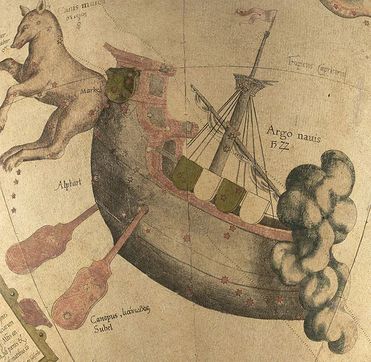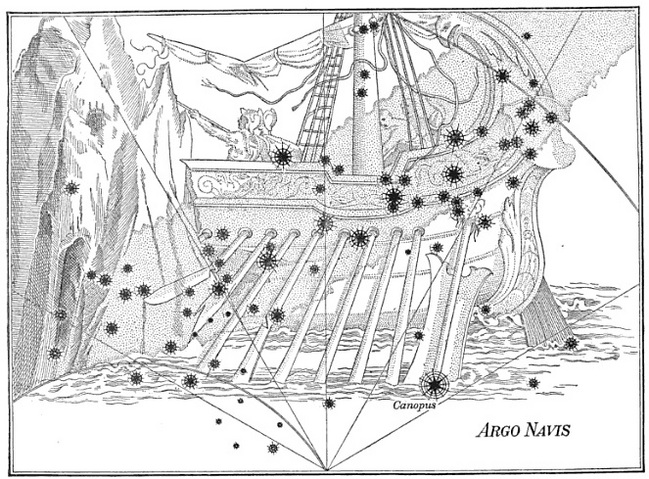ARGO NAVIS
The Greeks believed that the gods had carried the Argo up into the sky in honor of Jason's achievement, placing it beside Sirius as a constellation. It is probably a Greek interpretation of the Mesopotamian constellation, the Ship of the Canal of the Heavens. As originally conceived by the ancients, Argo Navis was the largest constellation in the night sky. It appeared in Ptolemy's Almagest and other ancient writings, but in 1752 the French astronomer Nicholas Louis de Lacaille recognized that it was too large and unwieldy. He divided it into three constellations: Carina (the keel), Puppis (the stern), and Vela (the sails). A fourth constellation, Pyxus (the compass), was detached from the mast and made into a completely independent constellation.
|
THE PHAENOMENA
Aratos c. 250 BCE ARATOS (c. 315-240 BCE) was Greek poet whose Phaenomena, based on earlier works, describes the constellations. In this work, Aratos describes the constellation of Argo Navis as it rotates backward across the heavens, trailing behind Sirius, the Dog-Star. Sternforward Argo by the Great Dog's tail Is drawn: for hers is not a usual course. But backward turned she comes, as vessels do When sailors have transposed the crooked stern On entering the harbor; all the ship reverse, And gliding backward on the beach it grounds. Sternforward thus is Jason's Argo drawn. And part moves dim and starless from the prow Up to the mast, but all the rest is bright. The slackened rudder has been placed beneath The hind-feet of the Dog, who goes in front. Source: Aratos, The Phainomena or 'Heavenly Display' of Aratos, trans. Robert Brown (London: Longmans, Green, and Co., 1885) |
From THE HISTORY OF THE PHYSICIANS
J. F. Hewitt
1896
J. F. HEWITT was a British commissioner in India and was much taken with the discovery that Indian mythology shared the same roots as Greek, what is today called Proto-Indo-European mythology, but was then known as Aryan myth. In "The History of the Physicians," an article to promote his books, The Ruling Races of Prehistoric Times, Hewitt attempted to prove that most major mythological figures were originally conceived as sun gods and most myths discussions of the sun's seasonal journey through the constellations, a common (but wrong) late Victorian theory. In so doing, Hewitt discusses the role of the Argo as the celestial boat. This line of inquiry, while going beyond the evidence, was nevertheless an early example of Proto-Indo-European comparative mythology and the anthropological practice of using myth to understand ritual and culture.
The name of Jason, the counterpart of Aesculapius, tells us that he was the god of healing (Tas), and he was the captain of the crew of the Argo on which Aesculapius also sailed; and the constellation which gave its name to this heavenly ship of the circling sun is one not visible in Greece. It was the star-ship Ma of the Akkadians of the Euphratean Delta, whose leader was the star Canopus, the Hindu god Agastya, who drank up the waters of the Indian Ocean and controls its tides in the historico-astronomical mythology of India and in that of the Zendavesta. It was this healing star who brought the divine ship Argo, drawn by the white sun-horse, the star Sirius, from the land of the south, to Argos, called after its name; and among its crew were the twin-gods of Night and Day; Kastor, called by the Akkadians, Turos, or the god of the revolving pole (tur); and Poludeukes, the much wetting (deuo) god. They were the sons of Leda, the mother of incense, Ledanon, obtained from the incense shrub Ledon, the Greek name for the Mastic (Pistaccia lentiscus) whence Greek incense was made. But the ritualistic use of incense in the temple of the Sun-god as a symbol of the mist and clouds wreathing the mountain top where the original creating god dwelt, was one that came from Central India, where the incense tree, the Salai (Boswellia thurifera) crowns every rocky height where nothing else will grow. It was first used in India in the temple services of the northern Turanian immigrants, who called themselves the sons of the mother-mountain, and who still in their national history tell how they were born from the mountain cave of the Himalayas, the source of the Jumna or Yamuna, the river of the twins (Yama), the sons of Saranyu, who came to Greece in the Argo. They, as the stars Gemini, the Ashvins of Hindu mythology, turned the stars round the pole, and their worshippers began their year with the summer solstice ruled by the star Sirius, when the sun reaches its most northerly point, which was in the first sun-voyage of the star ship Argo, Argos in Greece. It was the voyagers on this ship who introduced the year of Elis, beginning with the summer solstice and the season of the dog-days of Sirius; and they also brought from the East the art of healing by massage, the healing hand, and also the use of healing oil.
Source: J. F. Hewitt, “History of the Physicians and the Sun-God as the Great Physician,”Westminster Review 145 (1896): 358.





